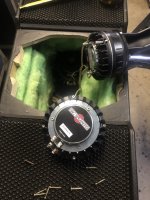It was pointed out (and to my uneducated brain make a bit of sense) that the crossover points are right in the middle of the critical range of hearing. It might be harder to cross nicely. Also I havent seen any reviews yet that give it a significant advantage (Im no expert so my statements are also questions...).
The 4594 seems to me as a well used option that I will also have more people/owners to ask for help.
BMS seems to be easy to cross 650 to 6500 (6.3k or something) so right on the critical range. no? Ro808 I believe pointed out some good things about the 464 but I might be to novice to get, i have to confess.
BMS goes easily higher to 20k (probably a minor detail for most)
The 464's overlap between the diaphragms is its strongpoint. Compared to some of the BMS coaxials the output of both diaphragms is more even, so a nice handover would be easier to realize. Mark100 did compare the B&C to the BMS and stated he had to get used to the lower XO point of the B&C.
I've heard the 4594Nd in the big Danley Synergies and have to admit they sound rather nice, at least for PA.
Moreover, the crappy magnet coating of every BMS driver deteriorates quickly due to oxidation. After a short period of time your expensive drivers will look old and abused. It's a shame, even though it doesn't affect performance.
I've heard the 4594Nd in the big Danley Synergies and have to admit they sound rather nice, at least for PA.
Moreover, the crappy magnet coating of every BMS driver deteriorates quickly due to oxidation. After a short period of time your expensive drivers will look old and abused. It's a shame, even though it doesn't affect performance.
Last edited:
the crappy magnet coating of every BMS driver deteriorates quickly due to oxidation
Nickel PRICE Today | Nickel Spot Price Chart | Live Price of Nickel per Ounce | Markets Insider
Zinc PRICE Today | Zinc Spot Price Chart | Live Price of Zinc per Ounce | Markets Insider
Peter Morris' comment on the DCX464:
"The DCX464 is a much newer design and I suspect they have improved a few things, especially the distortion levels. I also suspect it will make more SPL and go slightly lower. The mid / hi crossover has some overlap so it easier to get this area to work well.
The VHF does not go quite as high as the BMS4594, but so far it sounds more natural, in fact more natural (with Lake processing) than anything I have ever heard! ... but I am yet to use it in anger."
"The DCX464 is a much newer design and I suspect they have improved a few things, especially the distortion levels. I also suspect it will make more SPL and go slightly lower. The mid / hi crossover has some overlap so it easier to get this area to work well.
The VHF does not go quite as high as the BMS4594, but so far it sounds more natural, in fact more natural (with Lake processing) than anything I have ever heard! ... but I am yet to use it in anger."
Attachments
Last edited:
He says its only a misconception that you don't want to play below the fs. In a 6cuft box I can reach my 30hz 116db @ 1 meter loudness goal at 450watts versus the 800 needed for the 15h....so that would lower thermal compression potential right? There has to be some kind of benefit in the lowered xmax and larger wave front, of the larger diaphragm right? The group delay is 6ms higher but I just read, that group delay in sub the bass isn't a large factor. He spoke ofhow the 18h+ has a more powerful motor as well.
Last edited:
He's correct up to a certain point and assumed he knows his drivers better than anybody else, we'll have to take his arguments for granted. Tuning (reasonbly) below Xmax shouldn't cause problems, as long as the cab is big enough and the driver doesn't approach Xmech. At home, thermal compression isn't an issue, unless your average SPL is > 110dB.
I forgot to say that the 18h+ port would be tuned to 28hz. The 18h+ has significantly less excursion at the same spl as the 15h.....I'm scared, hold me. The 15H actually leaves xmax at this high level we are discussing, but the 18H+ never does. Which is still kind of a non issue since critical listening will be had at a much lower volume.
Last edited:
This is what I figured initially, after comparing both drivers, but we also have to take the larger cone into account. The 18H+ is a rather special breed. It's not exactly comparable to contemporary Pro 18" subwoofers, which are designed to go very loud in relatively small cabs. In order to play <40Hz these drivers need excessive Xmax as well as lots of amp. power. The 18H+' high VAS compensates for the lack of Xmax. The added bonus is higher sensitivity.
Besides, I've found that cone size does matter in the perceived quality of (sub)bass. By far the best bass I've heard and felt over the last 3 weeks was reproduced by a Funktion One stacked (4x) F221 horn.
Besides, I've found that cone size does matter in the perceived quality of (sub)bass. By far the best bass I've heard and felt over the last 3 weeks was reproduced by a Funktion One stacked (4x) F221 horn.
Could anyone, please, remind me what was so wrong with the JBL 4367(even the M2) as the 4367 sounds so goooood still? Yes, a bit shall I say thick in the lower mids but so warm and clean at the same time in the midrange and up? Is it all because of the D2340K?
Guys, please reach a conclusion, find the right horn/waveguide or whatever you call it and let's make that d@mn 2 way that camplo and EVERYBODY needs
Guys, please reach a conclusion, find the right horn/waveguide or whatever you call it and let's make that d@mn 2 way that camplo and EVERYBODY needs
4x18's in a basement, the ceiling would shudder, you feel it flexing.
Are those TD18H+ ?
@Camplo and AE TD18 H+: Some background: My room is a concrete bunker, walls, floor and ceiling 22-50 cm concrete ( 8,7”-19,7”) with roughly half of it below ground level. Good thing: Good sound isolation. Bad thing: It will contain a lot af bass = looong decay time and terrible room modes to tame. Size is 7,86 x 4,19 x2,20 m between concrete surfaces. (25,8’ x 13,7’ x 7,2’) with a lowest room mode at around 21,9 Hz theoretically.
If the TD18 H+ will be OK for you and reach down ”low enough at high SPL” may depend on you room. I planned (well at least I tried) taking my particuar circumstances in consideration. With a Qtc at ”usual” 0,707 in a concrete room my worries were about boomy bass, impossible to fix with reasonable amounts of absorbtion. So I went for a very low simulated Qtc (0,36) and sealed speakers in large boxes 174 L/element, 6,1 ft³. As sealed they should start to fall at around 12 dB/octave wth F3 at around 112 Hz and box resonsnce at around 48 Hz. My thougths were that placement and room gain should make up for quite a bit of that and below the lowest room mode around 20 Hz, rooms enters its pressure mode so SPL should increase again down into the infras. The 4 subs are placed at ¼ distance versus both width and height to even out width and height modes, leaving ”only” length modes as problematic to deal with.
If your room is totally different. -like a large living room with open planning, ”flimsy stud walls” with single sheets of drywall on each side, lots of windows and doors etc, it is a different ball game. It may not matter much if you use potent sub element(s) with very low tuning, the bass may just escape right out from the room and you are left with the direct sound ”only” with no / little help from room gain. Next post; some room measurements from today.
If the TD18 H+ will be OK for you and reach down ”low enough at high SPL” may depend on you room. I planned (well at least I tried) taking my particuar circumstances in consideration. With a Qtc at ”usual” 0,707 in a concrete room my worries were about boomy bass, impossible to fix with reasonable amounts of absorbtion. So I went for a very low simulated Qtc (0,36) and sealed speakers in large boxes 174 L/element, 6,1 ft³. As sealed they should start to fall at around 12 dB/octave wth F3 at around 112 Hz and box resonsnce at around 48 Hz. My thougths were that placement and room gain should make up for quite a bit of that and below the lowest room mode around 20 Hz, rooms enters its pressure mode so SPL should increase again down into the infras. The 4 subs are placed at ¼ distance versus both width and height to even out width and height modes, leaving ”only” length modes as problematic to deal with.
If your room is totally different. -like a large living room with open planning, ”flimsy stud walls” with single sheets of drywall on each side, lots of windows and doors etc, it is a different ball game. It may not matter much if you use potent sub element(s) with very low tuning, the bass may just escape right out from the room and you are left with the direct sound ”only” with no / little help from room gain. Next post; some room measurements from today.
Attachments
-
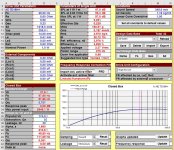 Sim 1 - 1xTD18H 1W.JPG220.6 KB · Views: 344
Sim 1 - 1xTD18H 1W.JPG220.6 KB · Views: 344 -
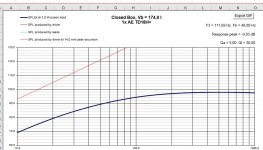 Sim 2 1xTD18H 1W.JPG119.8 KB · Views: 340
Sim 2 1xTD18H 1W.JPG119.8 KB · Views: 340 -
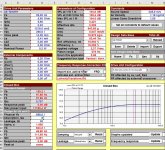 Sim 3 -4xTD18H 1 W 0,25 W each.JPG219.7 KB · Views: 336
Sim 3 -4xTD18H 1 W 0,25 W each.JPG219.7 KB · Views: 336 -
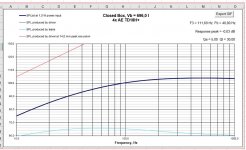 Sim 4 - 4xTD18H 1 W 0,25 wW each.JPG124.4 KB · Views: 335
Sim 4 - 4xTD18H 1 W 0,25 wW each.JPG124.4 KB · Views: 335 -
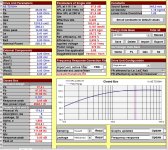 Sim 5 - 1xTD18H 250W.JPG222.9 KB · Views: 321
Sim 5 - 1xTD18H 250W.JPG222.9 KB · Views: 321 -
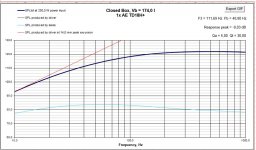 Sim 6 - 1xTD18H 250W 14 mm at 10 Hz.JPG118.5 KB · Views: 45
Sim 6 - 1xTD18H 250W 14 mm at 10 Hz.JPG118.5 KB · Views: 45
Last edited:
nope, 6th order ported boosted, high passed at Fs, q=2 so there is a +6db boost then acts like a subsonic below that.
$100 eminence blow outs, 4mm xmax each.
4 x 18's @4mm seemed to move air better than 4x12's with 8mm xmax.
Did you opt for the high Q + high pass for specific reasons?
My experience with separate subs is limited, but I am usually not very keen on high Q tuning.
- Home
- Loudspeakers
- Multi-Way
- Is it possible to cover the whole spectrum, high SPL, low distortion with a 2-way?
